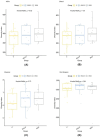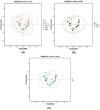Effects of Italian ryegrass with multi-enzymes supplementation on growth performance, gut microbial, and manure odor emission in finisher pig
- PMID: 39691618
- PMCID: PMC11647401
- DOI: 10.5187/jast.2024.e23
Effects of Italian ryegrass with multi-enzymes supplementation on growth performance, gut microbial, and manure odor emission in finisher pig
Abstract
This study investigated the effects of addition of Italian ryegrass with multi-enzyme on growth performance, fecal odor, and microbiome. The experiment had a two-factor factorial design, using three levels of Italian ryegrass (0%, 2.5%, and 5%) and two levels of multi-enzymes (no enzyme and commercially recommended level) to formulate experimental diets. In total, 60 crossbred Landrace × Yorkshire × Duroc (LYD) pigs (88.35 ± 2.57 kg) were allocated into six dietary treatments with five replicates. After four weeks, fecal samples were collected via rectal massage for microbiome and odorous compound analysis. Results showed no significant difference (p > 0.05) in growth performance, except for feed intake (p < 0.05), which was higher in enzyme-added diets. Fecal microbiome exhibited no differences (p > 0.05) between treatments, with Firmicutes and Bacteroidetes being the major phyla, similar to the general pig population. Alpha and beta diversity analyses showed no significant differences (p > 0.05). Odorous compounds displayed no significant differences (p > 0.05), except for indoles (p < 0.05) influenced by the enzyme. In conclusion, 5% Italian ryegrass with multi-enzymes can be used as an alternative feed ingredient, having no negative effects on the growth performance, microbiome, and odorous compounds of growing pigs.
Keywords: Growth performance; Italian ryegrass; Manure odor; Microbiome; Non-starch polysaccharide (NSP) enzyme.
© Copyright 2024 Korean Society of Animal Science and Technology.
Conflict of interest statement
No potential conflict of interest relevant to this article was reported.
Figures



Similar articles
-
Efficacy of a novel multi-enzyme feed additive on growth performance, nutrient digestibility, and gut microbiome of weanling pigs fed corn-wheat or wheat-barley-based diet.J Anim Sci. 2024 Jan 3;102:skae064. doi: 10.1093/jas/skae064. J Anim Sci. 2024. PMID: 38466229 Free PMC article.
-
Growth performance, bile acid profile, fecal microbiome and serum metabolomics of growing-finishing pigs fed diets with bile acids supplementation.J Anim Sci. 2023 Jan 3;101:skad393. doi: 10.1093/jas/skad393. J Anim Sci. 2023. PMID: 38006392 Free PMC article.
-
Effects of Replacing of Inorganic Trace Minerals by Organically Bound Trace Minerals on Growth Performance, Tissue Mineral Status, and Fecal Mineral Excretion in Commercial Grower-Finisher Pigs.Biol Trace Elem Res. 2016 Oct;173(2):316-24. doi: 10.1007/s12011-016-0658-7. Epub 2016 Feb 27. Biol Trace Elem Res. 2016. PMID: 26920735
-
Effects of amino acid composition in pig diet on odorous compounds and microbial characteristics of swine excreta.J Anim Sci Technol. 2017 Dec 11;59:28. doi: 10.1186/s40781-017-0153-5. eCollection 2017. J Anim Sci Technol. 2017. PMID: 29238606 Free PMC article.
-
Effects of dietary crude protein level and N-carbamylglutamate supplementation on nutrient digestibility and digestive enzyme activity of jejunum in growing pigs.J Anim Sci. 2020 Apr 1;98(4):skaa088. doi: 10.1093/jas/skaa088. J Anim Sci. 2020. PMID: 32201878 Free PMC article.
References
-
- Grogan D, Gilliland T. A review of perennial ryegrass variety evaluation in Ireland. Ir J Agric Food Res. 2011;50:65–81.
-
- Jung GA, Van Wijk AJP, Hunt WF, Watson CE. Ryegrasses. In: Moser LE, Buxton DR, Casler MD, editors. Cool‐season forage grasses. Madison, WI: American Society of Agronomy; 1996. pp. 605–41. p. - DOI
-
- Choi GJ, Lim YC, Rim YW, Sung BR, Kim MJ, Kim KY, et al. A cold-tolerant and early-heading Italian ryegrass new variety, ‘Kogreen’. J Korean Grassl Sci. 2006;26:9–14. doi: 10.5333/KGFS.2006.26.1.009. - DOI
-
- Agyekum AK, Nyachoti CM. Nutritional and metabolic consequences of feeding high-fiber diets to swine: a review. Engineering. 2017;3:716–25. doi: 10.1016/J.ENG.2017.03.010. - DOI
LinkOut - more resources
Full Text Sources

